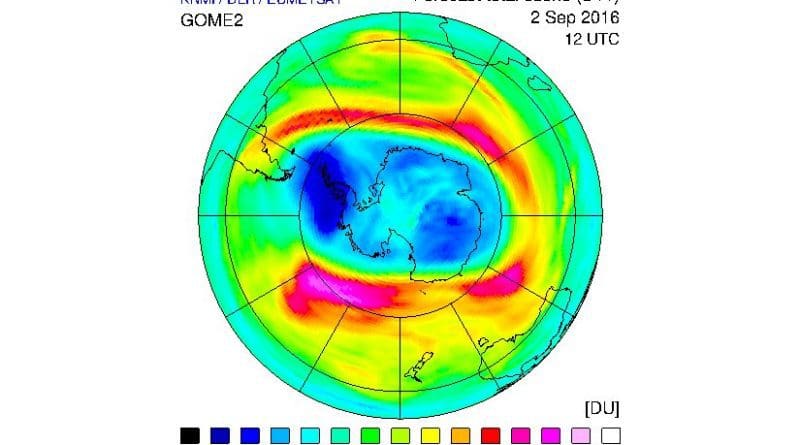Measuring Ozone From Space
Today is the UN’s International Day for the Preservation of the Ozone Layer – the perfect opportunity to look at how and why measurements of this molecule are taken from space.
The hole in the ozone layer over Antarctica became an international cause for concern in the latter half of the 20th Century, but as EUMETSAT’s Atmospheric Composition Product Development Team Leader Dr Christian Retscher points out, issues relating to ozone levels are complex and wide-reaching.
What is ozone?
Ozone is a molecule consisting of three oxygen atoms and occurs naturally in the atmosphere. However, close to the surface of the Earth, it is considered a pollutant.
The ozone layer in the stratosphere, with a bulk concentration at 15-30km above the surface of the Earth, is crucial for protecting humans and other species from the harmful effects of ultraviolet radiation from the sun, Christian said.
The ozone layer in the stratosphere absorbs UV radiation. While UV radiation is essential for life on Earth, it is also linked to skin cancer and damage to plant life. That is why the thinning of the ozone layer (often referred to as the ozone hole), causes concern.
But measurements of ozone in the troposphere (the lowest level of the Earth’s atmosphere, extending up to between 7km above sea level at polar regions and 20km over the tropics) are also needed because this molecule, which can be a by-product of industrial production, is harmful to breathe and damaging to plants.
About 90 percent of ozone is in the stratosphere and 10 percent in the troposphere, Christian said.
Measuring and monitoring ozone
EUMETSAT’s Metop-A (launched in 2006) and Metop-B (2012) satellites, flying in a sun-synchronised polar orbit approximately 817km above the Earth’s surface, carry an instrument called GOME-2 (Global Ozone Monitoring Experiment), which is dedicated to measuring ozone in the atmosphere.
“GOME-2 maps ozone from above,” Christian explained. “It takes total column (through the stratosphere and troposphere) ozone measurements.
“What is important about GOME-2 is that this is an instrument of an operational satellite mission, in other words, we are flying the same sensor more than once. This provides long time series of measurements, contributes to a better understanding of ozone production and destruction processes and also allows trend analysis.”
“The primary goal is to measure how the ozone layer is changing in general, not only the so-called ozone hole over Antarctica. There, meteorological conditions favour the accelerated depletion of stratospheric ozone, but ozone is thinning over the Arctic as well,” Christian said.
“When we look at how the ozone is behaving over the long term, what we hope to see is that stratospheric ozone is recovering somewhat.”
“Specifically, measurements from the last couple of years hint at a slight recovery of the stratospheric ozone layer over the South Pole.”
Ozone in the troposphere
“When we look at ozone with instruments like GOME-2, we see the whole column, but we want to separate between the troposphere and stratosphere,” Christian added.
“While ozone measurements in the stratosphere are more related to climate aspects, thus long-term effects, ozone in the troposphere has different implications for human health.
“When we are measuring ozone in the troposphere, short term trends or diurnal variations of ozone concentrations are much more relevant. We are interested in improvements over short time ranges like hours or days and much finer geographical scales, for example, cities.
“When inhaled, ozone is harmful to the respiratory system, so what is interesting is the understanding of changes of ozone levels on, for example, a daily basis. How much ozone is there and what is the threat level – is it safe for you to be outside or not? Novel instruments, for example, Sentinel-4, will support this kind of research since ozone profile data will be available on an hourly basis.”
Instruments measuring ozone
The GOME-2 instruments are dedicated to monitoring ozone but are not the only satellite-borne instruments taking ozone measurements.
Metop satellites also carry the Infrared Atmospheric Sounding Interferometer (IASI) instruments, which measure ozone as well.
Other relevant European ozone-monitoring instruments were GOME on ERS-2 , or SCIAMACHY, MIPAS and GOMOS, which were flown on ESA’s Envisat satellite. Very important contributions to ozone research are based on the more than 30 years time series of data from satellites flown by, for example, NASA and NOAA, with the successful series of TOMS , SBUV , POAM , and SAGE instruments or the later OMI or the OMPS sensors.
Planning is well in hand to continue monitoring ozone into the future.
Metop-A is approaching the end of its lifetime in space but Metop-C, also with a GOME-2 instrument, is expected to be launched in 2018, so the all-important long time series of measurements will be maintained.
Under the EU’s flagship Copernicus programme for monitoring the environment from space, EUMETSAT’s Meteosat Third Generation (MTG) geostationary meteorological satellites, and the EPS-Second Generation satellites will carry the Copernicus Sentinel-4 and -5 instruments respectively. Prior to these, ESA will launch the Sentinel-5 Precursor mission. All of these Sentinels have capacity to monitor ozone. In addition, there will be other European sensors in space supporting the monitoring of ozone, although not their primary mission objective, for example, IASI-NG (IASI- Next Generation) on EPS-SG and the IRS (Infrared Sounder) on MTG-S.
EUMETSAT will launch its EPS-SG satellites in the 2022-2042 timeframe, while the first in the series of MTG-S (sounding) platforms is expected to be launched in 2022 as well.

